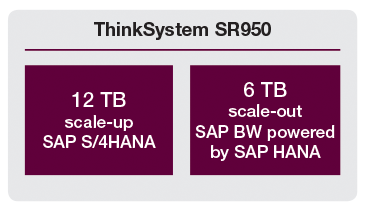Achieve Peak Performance for Your Big Data Needs
Getting the Best Results from SAP HANA with a Next-Generation Server
Today’s successful organizations understand the need to look toward the future, increasingly adopting next-generation platforms that will enable greater agility and speed in their IT organization. For many, this means adopting the latest offerings from SAP, such as SAP S/4HANA for their system of record or SAP BW/4HANA for advanced analytics. And in other cases, it can mean putting traditional SAP applications on top of SAP HANA to leverage the speed and power of the database. The underlying strategy looks different for all organizations, but the fact is that adopting SAP HANA is a critical aspect of many enterprises’ move toward the future of the digital enterprise.
The server that SAP HANA and other SAP systems sit on is a key component of the solutions themselves. Running a next-generation business suite on an outdated server platform that might not meet future capacity, sizing, or availability requirements limits the potential benefits that SAP HANA can provide the business: It would be like purchasing a custom luxury car and skimping on the powertrain. Most of the components of the state-of-the-art technology you’re looking for are present, but it doesn’t quite run as well as it could.
So what does the right server look like? It looks like a system that enables high availability, scalability, and reliability, fast performance, and the memory needed to handle massive amounts of data. If a company deploys SAP HANA on a server that has these traits, it sets itself on the road to success.
Running a next-generation business suite on an outdated server platform that might not meet future capacity, sizing, or availability requirements limits the potential benefits that SAP HANA can provide the business.
Support Larger Workloads with More Memory
These traits were among the many capabilities Lenovo strove for when it created its ThinkSystem SR950, a high-end, mission-critical server platform that is designed to be the primary platform for SAP customers using SAP HANA. Based on the next-generation Intel Xeon processor product family (code name Skylake), the ThinkSystem SR950 supports additional processing cores and enables support for larger SAP HANA memory configurations. In a recent study, the ThinkSystem SR950 experienced a performance improvement over the previous generation processor line of 38.5%.1
A quick look under the hood, so to speak, reveals the reason behind the additional power and support for SAP HANA memory configurations. The older x3950 X6 platform is an 8-socket system that supports up to 8 terabytes (8 TB) of memory in a scale-up SAP S/4HANA configuration or 4 TB in a scale-out cluster for SAP Business Warehouse (SAP BW) powered by SAP HANA. The SR950, conversely, supports up to 12 TB of memory in a scale-up SAP S/4HANA configuration or 6 TB in a scale-out cluster for SAP BW powered by SAP HANA, a 50% improvement in both cases (see Figure 1).

For the SAP HANA customer, then, the next-generation SR950 server platform supports larger workloads and provides them with the ability to consolidate existing SAP HANA landscapes. A business with a large SAP BW cluster that scales out to multiple nodes, for example, can reduce its server footprint by consolidating several nodes into a single SR950 system. An organization can also significantly reduce its total cost of ownership (TCO) with a reduction in rack size requirements, lower power and cooling costs, and fewer management resources. From the perspective of the SAP S/4HANA customer, the SR950 enables support for larger scale-up memory configurations, giving it room to grow as its SAP S/4HANA database size increases over time.
A 50% reduction in server footprint and reduced rack space, with the SR950 shrinking an 8-socket configuration into a 4-unit rack space along with more integrated storage in the form of 24 storage bays including up to 12 non-volatile memory express (NVMe) drives, helps businesses ensure that data center expansion can meet the demands of today’s rapidly growing enterprise data volumes. It enables the easy and rapid scalability that today’s enterprises need.
Combine these features and you have a server with the power and efficiency needed for SAP HANA workloads. A next-generation processor enables greater speed, while additional processing power and larger memory positions the server to handle the massive amounts of data that SAP HANA is designed for. Yet this increased performance also comes with decreased TCO and efficient scalability. By leveraging these capabilities, businesses can set themselves up to get the most from SAP HANA as well as SAP HANA-based platforms such as SAP S/4HANA and SAP BW/4HANA.
For SAP customers looking to take the next step toward the future by adopting SAP HANA technologies with an eye toward a lower TCO, a smaller data center footprint, and streamlined management, selecting servers that are designed for the demanding loads of SAP HANA is imperative.
Meeting Demands of a Digital Business
For companies running SAP Business Suite, the SR950 can provide the best-in-class performance, reliability, and availability benchmarks and features that are needed for critical production SAP workloads, including SAP HANA. These features include maximum uptime, “to-speed” maintenance, and system updates. For general SAP application landscapes, the SR950 is well-positioned for non-SAP traditional database workloads because of a high I/O bandwidth for connection to external storage.
In addition, the SR950 offers support for large-scale virtualized workloads for enterprises using VMware or another provider to virtualize application workloads at the application server tier or database tier in a classic landscape. Virtualization of SAP HANA with VMware is possible, but there are requirements and restrictions documented by SAP. More and larger application server virtual machines (VMs) on a single system for non-production workloads offers the organization greater flexibility to move VMs from one system to another as needed, or to quickly create a new VM for development or QA purposes.
For SAP customers looking to take the next step toward the future by adopting SAP HANA technologies with an eye toward a lower TCO, a smaller data center footprint, and streamlined management, selecting servers that are designed for the demanding loads of SAP HANA is imperative. By selecting a server platform with fast processing and robust memory support, businesses can set themselves up for continued success as they look toward a digital future. To learn more, visit www.lenovo.com/sap.
1 For a comparison of the performance improvements, see https://bit.ly/2uzV3VA and https://bit.ly/2tndeOS. [back]







